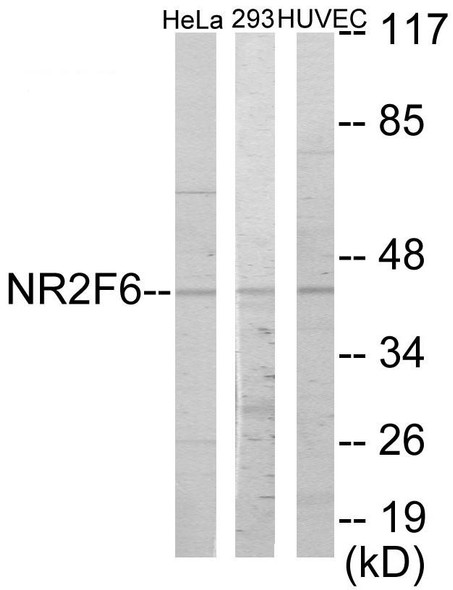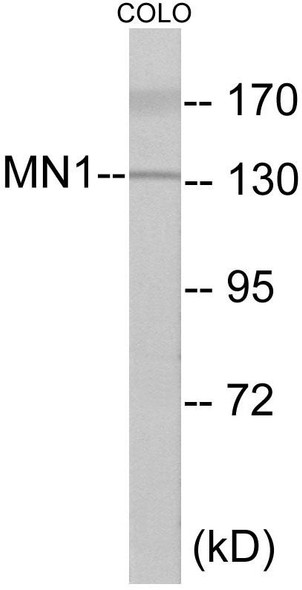Description
TF2H2 Colorimetric Cell-Based ELISA
The TF2H2 Colorimetric Cell-Based ELISA Kit is a cutting-edge tool designed for the accurate measurement of TF2H2 levels in cell lysates and tissue homogenates. This kit offers high sensitivity and specificity, providing reliable and reproducible results for a variety of research applications.TF2H2 is a key protein involved in DNA repair and transcription initiation, playing a crucial role in maintaining genomic stability and regulating gene expression. Dysregulation of TF2H2 has been linked to various diseases, including cancer and neurodegenerative disorders, making it a valuable biomarker for studying these conditions and developing potential therapeutic interventions.
With the TF2H2 Colorimetric Cell-Based ELISA Kit, researchers can efficiently analyze TF2H2 levels in a high-throughput manner, accelerating their research efforts and advancing our understanding of TF2H2-mediated pathways in health and disease. Invest in this innovative kit today and unlock new insights into TF2H2 biology.
| Product Name: | TF2H2 Colorimetric Cell-Based ELISA |
| Product Code: | CBCAB01093 |
| ELISA Type: | Cell-Based |
| Target: | TF2H2 |
| Reactivity: | Human, Mouse, Rat |
| Dynamic Range: | > 5000 Cells |
| Detection Method: | Colorimetric 450 nmStorage/Stability:4°C/6 Months |
| Format: | 96-Well Microplate |
The TF2H2 Colorimetric Cell-Based ELISA Kit is a convenient, lysate-free, high throughput and sensitive assay kit that can detect TF2H2 protein expression profile in cells. The kit can be used for measuring the relative amounts of TF2H2 in cultured cells as well as screening for the effects that various treatments, inhibitors (ie siRNA or chemicals), or activators have on TF2H2.
Qualitative determination of TF2H2 concentration is achieved by an indirect ELISA format. In essence, TF2H2 is captured by TF2H2-specific primary antibodies while the HRP-conjugated secondary antibodies bind the Fc region of the primary antibody. Through this binding, the HRP enzyme conjugated to the secondary antibody can catalyze a colorimetric reaction upon substrate addition. Due to the qualitative nature of the Cell-Based ELISA, multiple normalization methods are needed:
| 1. | A monoclonal antibody specific for human GAPDH is included to serve as an internal positive control in normalizing the target absorbance values. |
| 2. | Following the colorimetric measurement of HRP activity via substrate addition, the Crystal Violet whole-cell staining method may be used to determine cell density. After staining, the results can be analysed by normalizing the absorbance values to cell amounts, by which the plating difference can be adjusted. |
| Database Information: | Gene ID: 2966, UniProt ID: Q13888, OMIM: 601748, Unigene: Hs.191356/Hs.655216 |
| Gene Symbol: | TF2H2 |
| Sub Type: | None |
| UniProt Protein Function: | Component of the core-TFIIH basal transcription factor involved in nucleotide excision repair (NER) of DNA and, when complexed to CAK, in RNA transcription by RNA polymerase II. The N-terminus interacts with and regulates XPD whereas an intact C-terminus is required for a successful escape of RNAP II form the promoter. |
| NCBI Summary: | This gene is part of a 500 kb inverted duplication on chromosome 5q13. This duplicated region contains at least four genes and repetitive elements which make it prone to rearrangements and deletions. The repetitiveness and complexity of the sequence have also caused difficulty in determining the organization of this genomic region. This gene is within the telomeric copy of the duplication. Deletion of this gene sometimes accompanies deletion of the neighboring SMN1 gene in spinal muscular atrophy (SMA) patients but it is unclear if deletion of this gene contributes to the SMA phenotype. This gene encodes the 44 kDa subunit of RNA polymerase II transcription initiation factor IIH which is involved in basal transcription and nucleotide excision repair. Transcript variants for this gene have been described, but their full length nature has not been determined. A second copy of this gene within the centromeric copy of the duplication has been described in the literature. It is reported to be different by either two or four base pairs; however, no sequence data is currently available for the centromeric copy of the gene. [provided by RefSeq, Jul 2008] |
| UniProt Code: | Q13888 |
| NCBI GenInfo Identifier: | 17380326 |
| NCBI Gene ID: | 2966 |
| NCBI Accession: | Q13888.1 |
| UniProt Secondary Accession: | Q13888,Q15570, Q15571, Q9BS41, |
| UniProt Related Accession: | Q13888 |
| Molecular Weight: | 44,419 Da |
| NCBI Full Name: | General transcription factor IIH subunit 2 |
| NCBI Synonym Full Names: | general transcription factor IIH subunit 2 |
| NCBI Official Symbol: | GTF2H2 |
| NCBI Official Synonym Symbols: | p44; BTF2; TFIIH; BTF2P44; T-BTF2P44 |
| NCBI Protein Information: | general transcription factor IIH subunit 2 |
| UniProt Protein Name: | General transcription factor IIH subunit 2 |
| UniProt Synonym Protein Names: | Basic transcription factor 2 44 kDa subunit; BTF2 p44; General transcription factor IIH polypeptide 2; TFIIH basal transcription factor complex p44 subunit |
| UniProt Gene Name: | GTF2H2 |
| UniProt Entry Name: | TF2H2_HUMAN |
| Component | Quantity |
| 96-Well Cell Culture Clear-Bottom Microplate | 2 plates |
| 10X TBS | 24 mL |
| Quenching Buffer | 24 mL |
| Blocking Buffer | 50 mL |
| 15X Wash Buffer | 50 mL |
| Primary Antibody Diluent | 12 mL |
| 100x Anti-Phospho Target Antibody | 60 µL |
| 100x Anti-Target Antibody | 60 µL |
| Anti-GAPDH Antibody | 60 µL |
| HRP-Conjugated Anti-Rabbit IgG Antibody | 12 mL |
| HRP-Conjugated Anti-Mouse IgG Antibody | 12 mL |
| SDS Solution | 12 mL |
| Stop Solution | 24 mL |
| Ready-to-Use Substrate | 12 mL |
| Crystal Violet Solution | 12 mL |
| Adhesive Plate Seals | 2 seals |
The following materials and/or equipment are NOT provided in this kit but are necessary to successfully conduct the experiment:
- Microplate reader able to measure absorbance at 450 nm and/or 595 nm for Crystal Violet Cell Staining (Optional)
- Micropipettes with capability of measuring volumes ranging from 1 µL to 1 ml
- 37% formaldehyde (Sigma Cat# F-8775) or formaldehyde from other sources
- Squirt bottle, manifold dispenser, multichannel pipette reservoir or automated microplate washer
- Graph paper or computer software capable of generating or displaying logarithmic functions
- Absorbent papers or vacuum aspirator
- Test tubes or microfuge tubes capable of storing ≥1 ml
- Poly-L-Lysine (Sigma Cat# P4832 for suspension cells)
- Orbital shaker (optional)
- Deionized or sterile water
*Note: Protocols are specific to each batch/lot. For the correct instructions please follow the protocol included in your kit.
| Step | Procedure |
| 1. | Seed 200 µL of 20,000 adherent cells in culture medium in each well of a 96-well plate. The plates included in the kit are sterile and treated for cell culture. For suspension cells and loosely attached cells, coat the plates with 100 µL of 10 µg/ml Poly-L-Lysine (not included) to each well of a 96-well plate for 30 minutes at 37°C prior to adding cells. |
| 2. | Incubate the cells for overnight at 37°C, 5% CO2. |
| 3. | Treat the cells as desired. |
| 4. | Remove the cell culture medium and rinse with 200 µL of 1x TBS, twice. |
| 5. | Fix the cells by incubating with 100 µL of Fixing Solution for 20 minutes at room temperature. The 4% formaldehyde is used for adherent cells and 8% formaldehyde is used for suspension cells and loosely attached cells. |
| 6. | Remove the Fixing Solution and wash the plate 3 times with 200 µL 1x Wash Buffer for five minutes each time with gentle shaking on the orbital shaker. The plate can be stored at 4°C for a week. |
| 7. | Add 100 µL of Quenching Buffer and incubate for 20 minutes at room temperature. |
| 8. | Wash the plate 3 times with 1x Wash Buffer for 5 minutes each time. |
| 9. | Add 200 µL of Blocking Buffer and incubate for 1 hour at room temperature. |
| 10. | Wash 3 times with 200 µL of 1x Wash Buffer for 5 minutes each time. |
| 11. | Add 50 µL of 1x primary antibodies (Anti-TF2H2 Antibody and/or Anti-GAPDH Antibody) to the corresponding wells, cover with Parafilm and incubate for 16 hours (overnight) at 4°C. If the target expression is known to be high, incubate for 2 hours at room temperature. |
| 12. | Wash 3 times with 200 µL of 1x Wash Buffer for 5 minutes each time. |
| 13. | Add 50 µL of 1x secondary antibodies (HRP-Conjugated AntiRabbit IgG Antibody or HRP-Conjugated Anti-Mouse IgG Antibody) to corresponding wells and incubate for 1.5 hours at room temperature. |
| 14. | Wash 3 times with 200 µL of 1x Wash Buffer for 5 minutes each time. |
| 15. | Add 50 µL of Ready-to-Use Substrate to each well and incubate for 30 minutes at room temperature in the dark. |
| 16. | Add 50 µL of Stop Solution to each well and read OD at 450 nm immediately using the microplate reader. |
(Additional Crystal Violet staining may be performed if desired – details of this may be found in the kit technical manual.)






